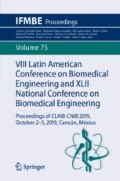Abstract
Cutaneous leishmaniasis is a parasitic disease transmitted by a vector prevalent in tropical rural areas affecting people with low economic resources. Treatments for this disease have significant adverse effects and a different therapeutic response in patients; therefore, accurate follow-up is necessary. Although there has been an increased interest in generating other options for treatment efficiency, the follow-up does not have standardized quantitative methods that allow an accurate estimation of the area and volume of the ulcer in the different phases of the disease. In this work, the proof of concept of a methodology based on photogrammetry was carried out to perform the quantitative follow-up of the treatment of cutaneous leishmaniasis ulcers in hamsters. For this, several stages were implemented, from the acquisition of videos by an in-house artificial vision system, to the measurement of ulcers using a commercial image processing software.
Access this chapter
Tax calculation will be finalised at checkout
Purchases are for personal use only
References
Zvietcovich Zegarra, J.F.: Estimación de volumen de lesiones producidas por leishmaniasis cutánea utilizando un escáner láser de triangulación 3D. Pontificia Universidad Católica Del Perú (2011)
Zvietcovich, F., Castaneda, B., Valencia, B., Llanos-Cuentas, A.: A 3D assessment tool for accurate volume measurement for monitoring the evolution of cutaneous leishmaniasis wounds. In: Proceedings of Annual International Conference on IEEE Engineering Medicine Biology Society, pp. 2025–2028 (2012). https://doi.org/10.1109/EMBC.2012.6346355
Casas, L., Castaneda, B., Treuillet, S.: Imaging technologies applied to chronic wounds: a survey. In: Proceedings of the 4th International Symposium on Applied Sciences in Biomedical and Communication Technologies, pp. 167:1–167:5. ACM, New York (2011)
Restrepo-Medrano, J.C., Verd, J.: Medida de la cicatrización en úlceras por presión, Con qué contamos. Gerokomos 22, 35–42 (2011). https://doi.org/10.4321/S1134-928X2011000100006
Conway, K.P., Price, P., Harding, K.G., Jiang, W.G.: The role of vascular endothelial growth inhibitor in wound healing. Int. Wound J 4 (2007). https://doi.org/10.1111/j.1742-481X.2006.00295.x
Reinke, J.M., Sorg, H.: Wound repair and regeneration. Eur. Surg. Res. 49, 35–43 (2012). https://doi.org/10.1159/000339613
Wilgus, T.A.: Immune cells in the healing skin wound: influential players at each stage of repair. Pharmacol. Res. 58, 112–116 (2008). https://doi.org/10.1016/j.phrs.2008.07.009
Diegelmann, R.F., Evans, M.C.: Wound healing: an overview of acute, fibrotic and delayed healing. Front. Biosci. 9, 283–289 (2004)
Singer, A.J., Clark, R.A.F.: Epstein1999_Woundhealing. N Engl. J. Med. 341, 738–746 (1999)
Kumar, S., Wong, P.F., Leaper, D.J.: What is new in wound healing? Turkish J. Med. Sci. 34, 147–160 (2004)
Prathiba, V., Gupta, P.D.: Cutaneous wound healing: significance of proteoglycans in scar formation. Curr. Sci. 78, 697–701 (2000). https://doi.org/10.1111/j.1752-1688.2001.tb03624.x
Fundación Universitaria del Área Andina CV (2015) Cicatrización: Proceso de reparación tisular. Aproximaciones terapéuticas. Rev. Investig. Andin. 12, 85–98
Acknowledgments
The authors are grateful for the support provided by Dr. Jorge Arévalo from the Universidad Peruana Cayetano Heredia, the English edition to Ada Tresierra García from Pontificia Universidad Católica del Perú and the financial support provided by the Administrative Department of Science and Technology of Colombia - COLCIENCIAS, Metropolitan Technological Institute, University of Antioquia, Universidad Pontificia Bolivariana and Kinetics Systems SAS (Medellín-Colombia), under project number 57186.
Author information
Authors and Affiliations
Corresponding author
Editor information
Editors and Affiliations
Rights and permissions
Copyright information
© 2020 Springer Nature Switzerland AG
About this paper
Cite this paper
Garzón-Márquez, C. et al. (2020). Follow-up of Cutaneous Leishmaniasis by Three-Dimensional Reconstruction Based on Photogrammetry: Proof of Concept. In: González Díaz, C., et al. VIII Latin American Conference on Biomedical Engineering and XLII National Conference on Biomedical Engineering. CLAIB 2019. IFMBE Proceedings, vol 75. Springer, Cham. https://doi.org/10.1007/978-3-030-30648-9_53
Download citation
DOI: https://doi.org/10.1007/978-3-030-30648-9_53
Published:
Publisher Name: Springer, Cham
Print ISBN: 978-3-030-30647-2
Online ISBN: 978-3-030-30648-9
eBook Packages: EngineeringEngineering (R0)

